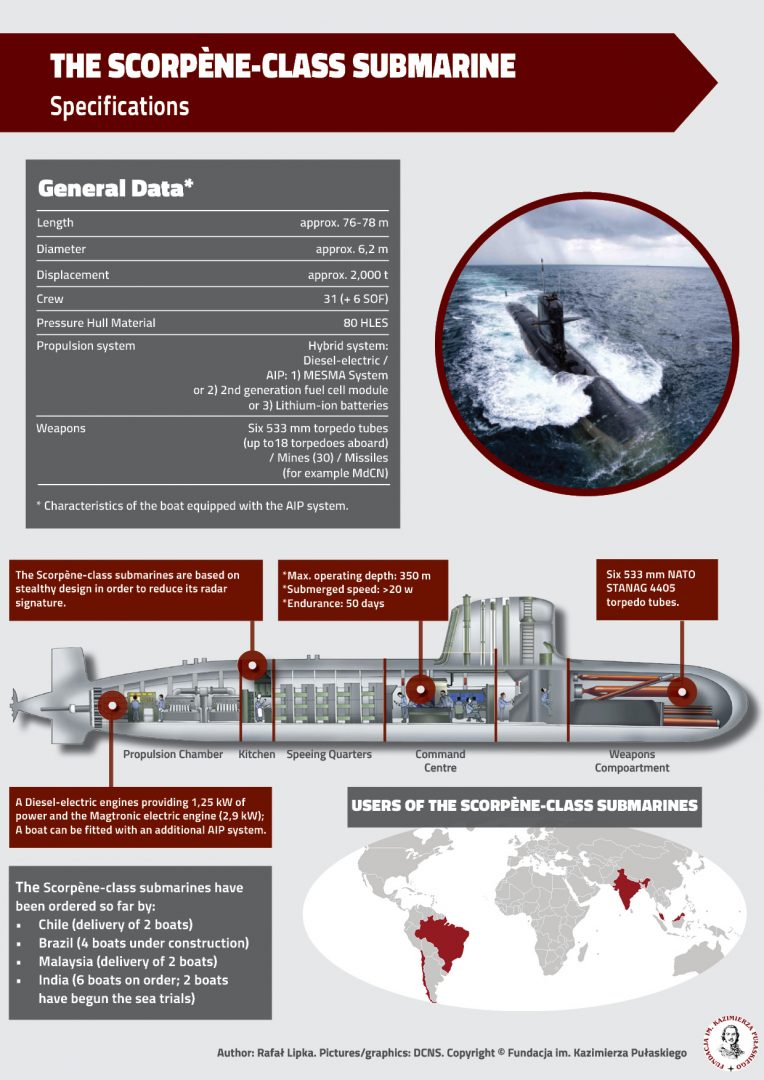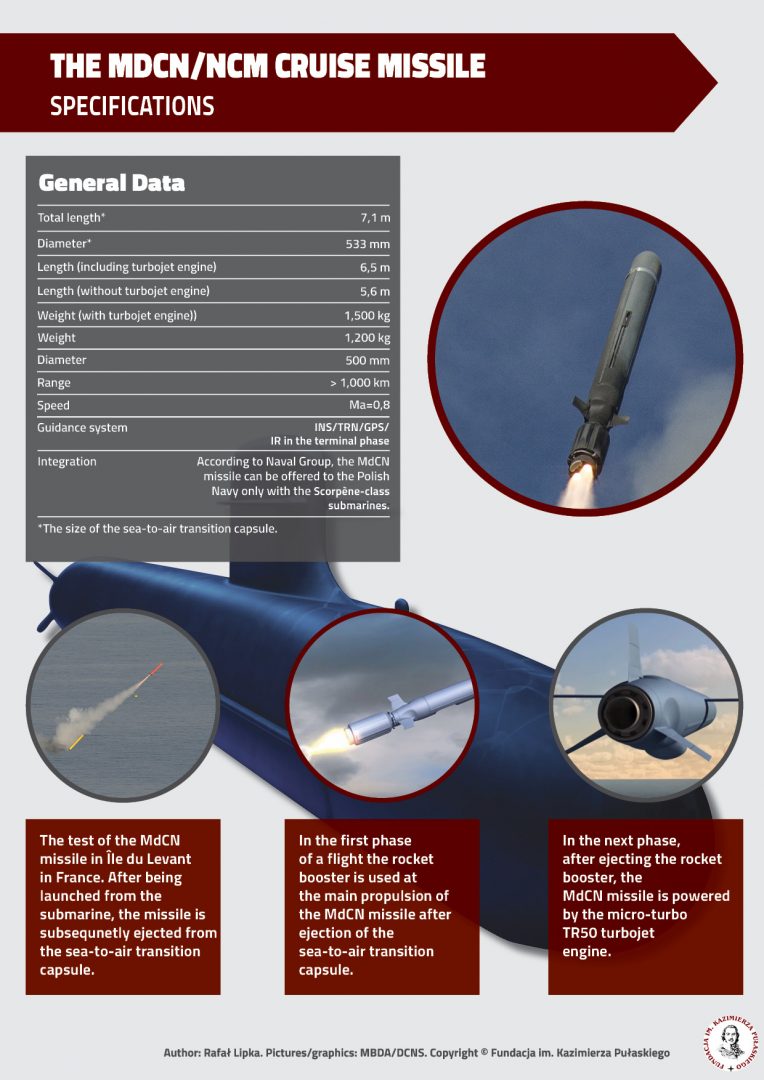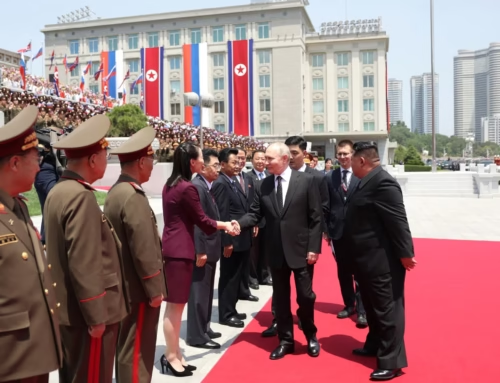PP ANALYSIS Poland’s ‘Orka’ submarine program. Part 2. The Scorpène class submarines – Naval Group
Autor foto: Domena publiczna

Poland’s ‘Orka’ submarine program. Part 2. The Scorpène class submarines – Naval Group
September 26, 2017
Author: Rafał Lipka




PP ANALYSIS Poland’s ‘Orka’ submarine program. Part 2. The Scorpène class submarines – Naval Group
Autor foto: Domena publiczna
Poland’s ‘Orka’ submarine program. Part 2. The Scorpène class submarines – Naval Group
Author: Rafał Lipka
Published: September 26, 2017
Pulaski Policy Paper no 20, September 26, 2017
On May 18 2017, the Pulaski Foundation organized the second in a series of three seminars concerning the ‘Orka’ submarine acquisition program, dedicated to the Scorpène-class vessels. The participants had the opportunity to familiarize themselves with detailed information on the French offer, delivered by representatives of Naval Group (formerly DCNS, Direction des Constructions Navales Services).
Naval Group is currently perceived as the main competitor to the German shipbuilding industry in the field of modern conventional submarines. The French Navy decided to operate only nuclear submarines, decommissioning all conventional vessels. The French shipyard industry, however, continues to develop conventional submarines, actively seeking new contracts abroad. The Scorpène-class submarines were ordered by Brazil (4 vessels), Chile (2), Malaysia (2) and India (6). Furthermore, in 2016, DCNS won a US$39bn contract to build a fleet of 12 conventional submarines, based on the Barracuda-class nuclear-powered submarines, for the Australian Navy. In this tender, the French company beat its German (ThyssenKrupp Marine Systems with the Type 216 submarine, which is based on the Type 212/214) and Japanese competitors (Mitsubishi Heavy Industries Ltd. and Kawasaki Heavy Industries Ltd. with the Sōryū-class submarine). Therefore, the French shipbuilding industry is becoming an ever more important player in construction of conventional submarines, overcoming Germany’s dominance in this sector. Undoubtedly, Naval Group’s success proved that the company can provide high-performance vessels despite a lack of conventional submarine contracts for the French government.
Both Naval Group and ThyssenKrupp Marine Systems (the Type 214 submarine) based their vessel designs to meet specific export requirements. For the Indian and Brazilian contracts, Naval is obliged to build all submarines in local shipyards and carry out a technology transfer process. The Scorpène-class submarine has been designed as a multipurpose vessel, capable of operating in various environments and performing a wide range of missions, according to the requirements of foreign customers. Therefore, the submarine can be perceived as a direct competitor of the German Type 214, in contrast to the Type 212A and the Swedish A26 submarine whose design was based on different operational requirements. Undoubtedly, the flexibility is a key attribute of the French design. Given the requirements of the Polish Ministry of Defense, Naval Group has offered various types of armament and equipment, including three variants of the air independent propulsion. The key advantage of the French vessel, besides its technical specifications, is the possibility to equip Polish Navy units with the MdCN/NCM (Missile de Croisière Naval/Naval Cruise Missile) surface attack cruise missiles. This issue will require further analysis since SAAB and TKMS are not capable to offer submarines integrated with cruise missiles. Therefore, the procurement of submarines from the German and Swedish companies is related to additional technical and political difficulties.
The Scorpène-class submarine: Specifications

Naval offers three air independent propulsion modules. The first, the MESMA (Module d’Energie Sous-Marine Autonome) system is a modified version of the nuclear propulsion system used on French ballistic submarines, in which a turbine power plant is powered by steam produced by the combustion of liquid oxygen and diesel fuel. Consequently, the electric current from the turbo generator is used to charge boat’s batteries. Exhaust gases (carbon dioxide) mixed with water need to be discharged overboard. The MESMA system is cooled by sea water. In contrast to the AIP system offered by TKMS, the MESMA system requires no additional systems that could hinder submarine resupply (such as the hydrogen supply for German submarines). On the other hand, the system has a relatively high level of oxygen consumption (1.1 kg/kW compared to 0.4 kg/kW on German submarines and 1.0 kg/kW in the case of the Swedish A26 submarine). Moreover, the boat equipped with the MESMA system cannot compete with the performance of the German and Swedish submarines. The Scorpène-class submarine with the MESMA AIP system has an operating speed of 4 kn (compared to 8 and 6 knots for the German Type 212A/214 and Swedish A26 submarines, respectively) and lower energy conversion efficiency (25%) in comparison to its competitors. The MESMA system, however, is based on design that was intended to reduce life-cycle costs and simplify maintenance, which is certainly an important advantage of the French offer. Naval Group installed the MESMA AIP system on three Agosta-90B class submarines built for the Pakistan Navy, making it the only operationally-verified French AIP. However, the Scorpène-class submarines have not been integrated with the MESMA system thus far. Vessels with conventional propulsion systems (without the AIP) can remain submerged up to 7 days.
The next system offered by Naval Group is the so-called second-generation fuel cell AIP module. In contract to the German submarine, the system does not require to store hydrogen in special tanks. Hydrogen is produced from water and diesel fuel on board; consequently making it safer to operate for the crew and the vessel. According to the producer, the submarine equipped with the fuel cell AIP system can remain submerged for three weeks at a speed of 4 knots. The technical specification of this system has not been published, so it is currently impossible to compare the French propulsion with its German competitors. However, it is worth noting that the fuel cell AIP system for the Scorpène-class has not been tested at sea.
The third propulsion system offered by Naval Group is based on Lithium-Ion batteries. The batteries are, intended to provide the energy on the same basis as the air independent propulsion systems instead of replacing the main battery storage. The Li-Ion batteries, however, cannot compete with other AIP systems in terms of performance. A submarine equipped with batteries can only be submerged for a week at a speed of 4 knots, or one day at a speed of 12 knots. Considering that endurance is one of the key parameters for a cruise missile submarine, the Li-Ion batteries seem to be unfit for the Polish Navy.

The Scorpène-class submarine is equipped with six 533 mm NATO STANAG 4405 torpedo tubes. French submarines can carry up to 18 torpedoes (more than the German type 212A/214 submarine). A standard torpedo tube is able to deploy mines (30 mines instead of torpedoes) and launch Black Shark and F21 torpedoes, as well as missiles such as MdCN/NSM or antiship SM39 Exocet missiles. Resupply of Ammunition, however, requires dismantling of a part of the hull over the submarine’s torpedo compartment. The vessel is offered with the Contralto-S anti-torpedo system.
The MdCN/NSM cruise missiles that have a range of over 1,000 km (and thus provide the capability to attack land targets) are an integral part of the French offer. Unlike the German and Swedish producers, the Naval Group offers cruise missile integration. The French company has refused to integrate their boats with the UGM-109 Tomahawk missile. It is worth noting that the German and Swedish submarines are not equipped with cruise missiles at all. Therefore, further negotiations with Raytheon (manufacturer of the Tomahawk missile) and the American administration (US Department of Defense) would be needed to meet the requirements of the ‘Orka’ program.
Conclusions and recommendations
1. The French submarines with the MdCN/NCM missiles are offered as a complete and integrated system, a major advantage of Naval Group’s offer. Submarines equipped with land- attack cruise missiles produced by MBDA can provide Poland with the power projection capabilities. Not only do the missiles provide the Navy with an opportunity to conduct retaliatory strikes, but also the navy vessels will be able to participate in joint land-air-sea operations. Thus the procurement of the Scorpène-class submarines equipped with the MdCN/NSM cruise missiles will not be as complicated as the acquisition of Swedish or German boats. It is worth noting that the competitors of Naval Group currently do not offer submarines integrated with cruise missiles. Therefore, Poland would have to enter into additional, inter-governmental negotiations to procure the American Tomahawk missiles and subsequently integrate this weapon with new submarines.
2. The three AIP systems offered by the Naval Group all have their pros and cons. The MESMA system has been successfully integrated with the Agosta-90B class submarines of the Pakistan Navy. Despite its lower performance as compared to the fuel cells used on German boats, the MESMA system has a proven and simplified design based on the nuclear propulsion of French nuclear submarines. MESMA system also has a relatively low life-cycle cost, simple design and maintenance. According to the representatives of Naval Group, the Polish defense industry will be capable to ensure the maintenance of the MESMA system without additional support of the manufacturer. The Li-Ion batteries seem insufficient to meet operational requirements of the Polish MoD, particularly due to lower endurance when the submarine remains submerged. Given the fact that Polish future submarines will be equipped with cruise missiles, this parameter ought to be perceived as absolutely crucial. The 2nd generation fuel cells, however, seem to be an interesting alternative to the MESMA system, particularly since they do not require special hydrogen tanks on board. The French fuel cells are currently undergoing tests, and the Polish submarines might be the first boats equipped with this system. Certainly, the technology risks related to this system should be taken into consideration by Polish administration.
3. The main weakness of the French offer is a lack of a submarine that could be temporarily used as a training boat for the Polish Navy in order to fill the gap in Poland’s naval capabilities until the launch of new vessels. On the other hand, Naval Group offered to establish a modern training system in Poland and suggested that Polish sailors could also receive training on board of the French nuclear submarines. Naval Group’s training system is supposed to be based on simulators and other specialized infrastructure in order to minimize the use of the submarines. According to the French producer, this infrastructure can cover up to 80 percent of the training courses.
4. The Scorpène-class submarines are based on proven and modern design, which was successfully offered abroad despite the lack of orders from the French Navy. Unlike its German competitor (212A) the vessels has not been designed for Baltic Sea operations, but for completely different requirements, similar to those for the Type 214 submarine. However, the Scorpène-class vessels can carry out a wide range of missions, so they can meet different operational requirements specified by the Polish Navy.
5. While details of cooperation between the Polish Armaments Group and the Naval Group, such as the participation of Polish companies in the supply chain are still under negotiation. However, acquiring the Scorpène-class submarines can provide the Polish defense industry with an opportunity to establish cooperation and strong economic relations with the French shipbuilding industry and gain from transfer of technology. Naval Group is also able to offer interesting systems and solutions for other Polish modernization programs (e.g. construction of new corvette naval vessels like ‘Miecznik’ and ‘Czapla’ programs). The French producer ensures that about 80 percent of construction work can be located in Poland, creating over 1,200 jobs in Poland, and another 300 jobs related to the maintenance and exploitation in future. Naval Group claims that companies such as PIT RADWAR, CTM, Vistal Gdynia and MSR could possibly join the supply chain of the French shipbuilding company.
6. The selection of the Scorpène-class submarines is also a chance to improve bilateral relations between Paris and Warsaw. The acquisition itself will have no long-term political impact as far as the security of Poland is concerned (especially in terms of the French perception of the deployment of NATO forces in Poland; the political tensions between Poland and France remain a separate issue).
Author: Rafał Lipka, Analyst of the ‘Defence and Security Programme’ at the Casimir Pulaski Foundation





